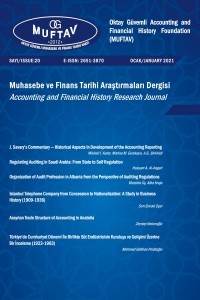XIV. Yüzyılda Ortadoğu’da Yazılmış Muhasebe Kitabı Risale-i Felekiyye’nin İlk Bölümleri
XIV. Yüzyılda İlhanlılar’ın (1256-1353) gelişmiş bir mali düzene sahip oldukları bilinmektedir. Geniş Ortadoğu coğrafyasını yöneten bu Moğol devletinden bugünlere kalan devlet muhasebe öğreti kitapları önem taşımaktadır. 1309-1363 Yılları arasında yazılmış bu muhasebe kitapları, hem çağının ileri düzeyde muhasebe disiplininin örneklerini sergilemekte ve hem de Ortadoğu’da bin yıldan daha uzun süre kullanılmış olan Merdiven yönteminin tanıtımını yapmaktadır. Bu kitaplardan sonuncusu olan Risele-i Felekiyye, sözü edilen yöntemi tanıtan son kitaptır. Osmanlı bu yöntemi bu kitabın yazıldığı yıllarda İlhanlılar’dan almış, beş yüz yıl boyunca geliştirerek kullanmıştır. Ama yöntemi tanıtıcı bir kitap yazmak ihtiyacını duymamıştır.Kitap siyakat yazısı ile yazılmış muhasebe örneklerini içermektedir. Önce matematik ve hesaplama kuralları, sonra kayıt usul ve kaidelerine yer verilmiştir. Daha sonra da devlet mali sisteminin muhasebe defter düzeni örneklerle anlatılmıştır. Defter düzeni esas olarak, ruznamçe (günlük defter) ve evarece (büyük defter) den oluşmaktadır. Çünkü kayıtların tamamı bu defterlerde yer almaktadır. Öteki defterler yardımcı niteliktedir ve mali yönetimin ihtiyaç duyduğu kimi olayların kayıt ihtiyacını karşılamaya dönüktür. Kitapta, Sistemi oluşturan ana ve yardımcı defterlerin tanıtımından sonra uzlanım muhasebeleri defterlerine (ahır defteri, inşaat defteri, çeltik defteri, ambar defteri, darphane defteri, koyun defteri, hazine defteri) yer verilmektedir. Bu çalışmada kitabın altıncı ana bölümünün başına kadar olan kısım ele alınmıştır.
Anahtar Kelimeler:
Devlet muhasebesi, merdiven yöntemi, Risale-i Felekiyye.
The First Sections of an Accounting Book Written in the Middle East in the 14th Century: Risale-i Felekiyye
It is known that the Ilkhanate State (1256-1353 A.D.) had an advanced financial structure in the 14th century and introduce the Merdiban (Stairs) method, which had been used for a thousand years in the Middle East. Risale-i Felekiyye is the last accounting teaching book of the mentioned era. The Ottoman 14th century. This Mongol state has ruled the large Middle Eastern territory and they had important accounting teaching books, which remained until today. Those accounting teaching books demonstrate an advanced accounting discipline Empire took this book from the Ilkhanate, improved and practiced it for five hundred years. But, the Ottoman Empire never felt the need to write an introductory book about the mentioned method. The book constitutes accounting examples written with the Siyakat script. Math and calculation rules are the first part of its content, and then it is followed by registration procedures and rules. Afterwards, state’s financial structure and layout of the accounting books are introduced with examples. Mainly, layouts of the accounting books consist of ruznamçe (daily book) and evarece (ledger). That is because all the records are presented within those books. Other books have auxiliary characteristics and they occur mainly for the recording needs of special occasions. After introducing the main and the subsidiary books, the book gives information about specialized accounting books (stable books, construction books, rice book, warehouse book, minting house book, sheep book, treasury book). This study examines until the beginning of the sixth chapter of this book.
Keywords:
State accounting, Merdiban method, Risale-i Felekiyye,
- ISSN: 2146-4928
- Yayın Aralığı: Yılda 2 Sayı
- Başlangıç: 2011
- Yayıncı: Oktay Güvemli Muhasebe ve Finans Tarihi Vakfı (MUFTAV)
Sayıdaki Diğer Makaleler
Tarih Boyunca Muhasebe Uygulama ve Eğitim Araçları
Mikail EROL, İsmail ELAGÖZ, Seçil ÖZTÜRK
Ortadoğu’da Yazılı İlk Muhasebe Öğreti Eseri: Saadetname
Cemal ELİTAŞ, Bilge Leyli ELİTAŞ
Türkiye’deki Muhasebe Sisteminin Gelişiminin Kurumsal Teori Çerçevesinde Açıklanması
2012 YILINDA ULUSLARARASI KONFERANS VE KONGRELER
XIV. Yüzyılda Ortadoğu’da Yazılmış Muhasebe Kitabı Risale-i Felekiyye’nin İlk Bölümleri
